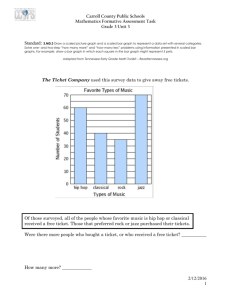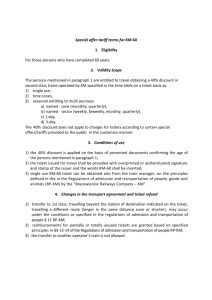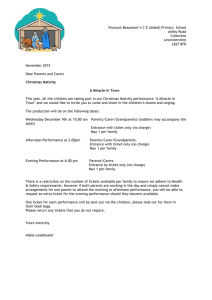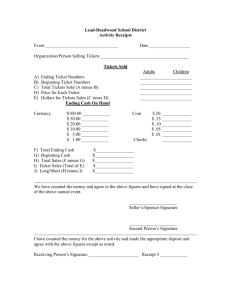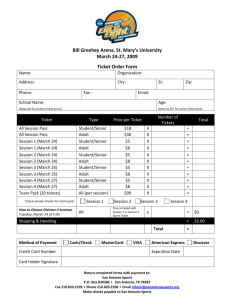Q a bP = +
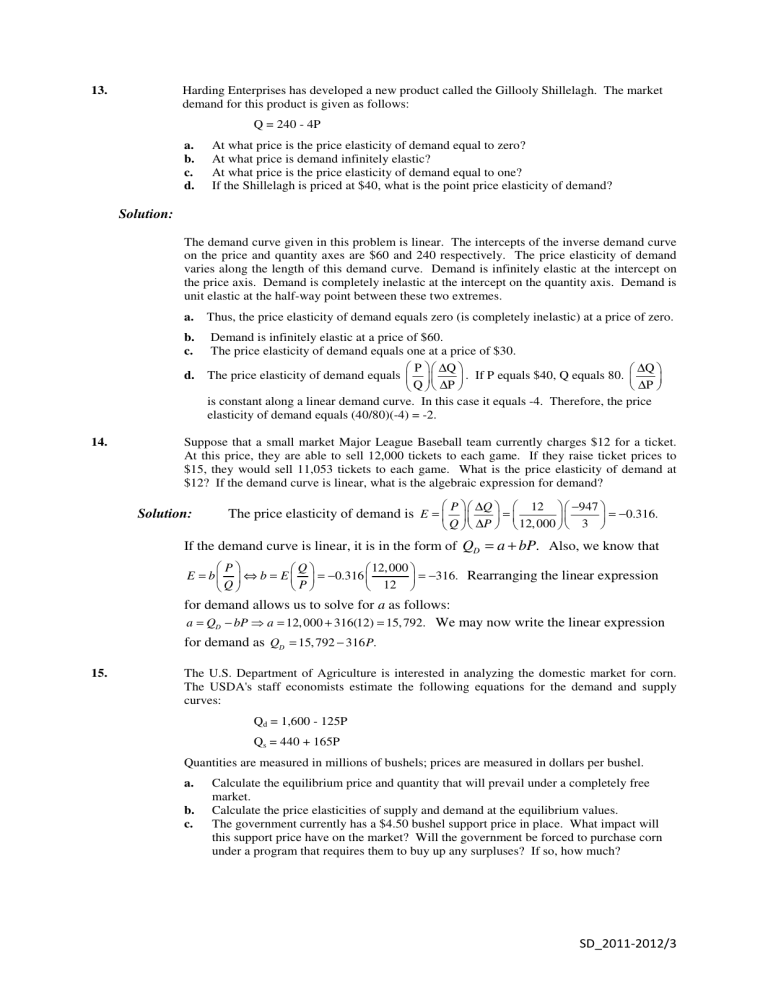
13.
Solution:
Harding Enterprises has developed a new product called the Gillooly Shillelagh. The market demand for this product is given as follows:
Q = 240 - 4P a.
At what price is the price elasticity of demand equal to zero? b.
At what price is demand infinitely elastic? c.
At what price is the price elasticity of demand equal to one? d.
If the Shillelagh is priced at $40, what is the point price elasticity of demand?
14.
The demand curve given in this problem is linear. The intercepts of the inverse demand curve on the price and quantity axes are $60 and 240 respectively. The price elasticity of demand varies along the length of this demand curve. Demand is infinitely elastic at the intercept on the price axis. Demand is completely inelastic at the intercept on the quantity axis. Demand is unit elastic at the half-way point between these two extremes. a.
Thus, the price elasticity of demand equals zero (is completely inelastic) at a price of zero. b.
Demand is infinitely elastic at a price of $60. c.
The price elasticity of demand equals one at a price of $30. d.
The price elasticity of demand equals
P
Q
∆
∆
Q
P
. If P equals $40, Q equals 80.
∆
∆
Q
P
is constant along a linear demand curve. In this case it equals -4. Therefore, the price elasticity of demand equals (40/80)(-4) = -2.
Suppose that a small market Major League Baseball team currently charges $12 for a ticket.
At this price, they are able to sell 12,000 tickets to each game. If they raise ticket prices to
$15, they would sell 11,053 tickets to each game. What is the price elasticity of demand at
$12? If the demand curve is linear, what is the algebraic expression for demand?
Solution:
The price elasticity of demand is
E =
P
∆ Q
Q ∆ P
=
12
12, 000
− 947
3
= − 0.316.
If the demand curve is linear, it is in the form of
Q
D
= a + bP .
Also, we know that
E = b
P
Q
⇔ b = E
Q
P
= − 0.316
12, 000
12
= − 316.
Rearranging the linear expression for demand allows us to solve for
a
as follows:
a = Q
D
− bP
⇒ a =
We may now write the linear expression for demand as
Q
D
= P
15. The U.S. Department of Agriculture is interested in analyzing the domestic market for corn.
The USDA's staff economists estimate the following equations for the demand and supply curves:
Q d
= 1,600 - 125P
Q s
= 440 + 165P
Quantities are measured in millions of bushels; prices are measured in dollars per bushel. a.
Calculate the equilibrium price and quantity that will prevail under a completely free market. b.
Calculate the price elasticities of supply and demand at the equilibrium values. c.
The government currently has a $4.50 bushel support price in place. What impact will this support price have on the market? Will the government be forced to purchase corn under a program that requires them to buy up any surpluses? If so, how much?
SD_2011-2012/3
Solution: a.
Set Q
d
= Q
s
to determine price.
1600 - 125P = 440 + 165P
1160 = 290P
P = 4
Obtain Q by substituting into either expression.
Q d
= 1600 - 125(4)
Q d
= 1600 - 500
Q = 1100
P * = $4, Q * = 1100 b.
For the Own Price Elasticity of Demand
E = − 125 ×
4
1100
= − 0.45
(approximately)
For the Own Price Elasticity of Supply E = 165
4
×
1100
= 0.60
c. Calculate Q d
and Q s
at the $4.50
price
Q d
= 1600 - 125( 4.5
)
Q d
= 1037.5
Q s
= 440 + 165( 4.5
)
Q s
= 1182.5 surplus = Q s
- Q d
= 1182.5 - 1037.5 = 145
The support price would create an excess supply of 145 million bushels that the government would be forced to buy.
SD_2011-2012/3
16. American Mining Company is interested in obtaining quick estimates of the supply and demand curves for coal. The firm's research department informs you that the elasticity of supply is approximately 1.7, the elasticity of demand is approximately -0.85, and the current price and quantity are $41 and 1,206, respectively. Price is measured in dollars per ton, quantity the number of tons per week. a.
Estimate linear supply and demand curves at the current price and quantity. b.
What impact would a 10% increase in demand have on the equilibrium price and quantity? c.
If the government refused to let American raise the price when demand increased in (b) above, what shortage is created?
Solution: a. First we estimate the demand curve
Q = a
O
- b
O
P
Elastiticy of demand = b
0
×
P
Q
41
.85
= b
0
×
1206
-1025.1 = b
O
x 41 b
O
= 25
Q = a
O
- b
O
P
1206 = a
O
- 25(41)
1206 = a
O
- 1025 a
O
= 2231
Q
D
= 2231 - 25P
SD_2011-2012/3
Next, we estimate the supply curve
Q = a
1
+ b
1
P
Elasticity of Supply = b
1
×
P
Q
1.7
= b
1
41
×
1206
2050.2x = b
1
x 41 b
1
= 50
Q = a
1
+ b
1
P
1206 = a
1
+ 50(41) a
1
= -844
Q
S
= -844 + 50P
Check to see if correct:
Set Q s
= Q d
2231 - 25P = -844 + 50P
3075 = 75P
P = 41
The equations are correct. b.
Multiply demand equation by 1.10
1.10 (2231 - 25P)
Q d
' = Q s
and solve
Q s
= -844 + 50P
Set Q d
' = Q s
and solve.
2454.1 - 27.5P
= -844 + 50P
3298.1 = 77.5P
P = 42.56
Substitute P into Q d
' to find quantity demanded
Q d
' = 2454.1 - 27.5(42.56)
Q d
' = 1283.7 or 1284
SD_2011-2012/3
17. c.
Since price cannot rise, the shortage will be the quantity demanded with the new demand minus the quantity supplied with the unchanged supply
Quantity demanded: Q = 2454.1 - 27.5(41) = 1326.6
Quantity supplied: Q = -844 + 50(41) = 1206.0
Shortage = 1326.6 - 1206.0 = 120.6
In a city with a medium sized population, the equilibrium price for a city bus ticket is $1.00, and the number of riders each day is 10,800. The short-run price elasticity of demand is -0.60, and the short-run elasticity of supply is 1.0. a.
Estimate the short-run linear supply and demand curves for bus tickets. b.
If the demand for bus tickets increased by 10% because of a rise in the world price of oil, what would be the new equilibrium price of bus tickets? c.
If the city council refused to let the bus company raise the price of bus tickets after the demand for tickets increases (see (b) above), what daily shortage of tickets would be created? d.
Would the bus company have an incentive to increase the supply in the long run given the city council’s decision in (c) above? Explain your answer.
Solution:
Given: P* = $1.00 per ticket Q* = 10,800
E d
= -0.60 E s
= 1.0 a.
Demand: Q d
= a
O
+ a
1
P Supply: Q s
= b
0
+ b
1
P
Use:
E =
P
Q
×
∆ Q
to compute a
1
and b
1
.
∆ P
E d
=
1
10,800 a
1
E s
=
1
10,800 b
1
1
− 0 .
60 =
10,800 a
1 a
1
= -6,480
Solve for a
O
Q d
= a
O
+ a
1
P
1 .
0 =
1
10,800 b
1 b
1
= 10,800
Solve for b
Q s
= b
O
+ b
O
1
P
10,800 = a
0
-6,480.00(1.0) 10,800 = b
0
+10,800.00(1.0) a
O
= 17,280 b
O
= 0.0
Q d
= 17,280 - 6,480P Q s
= 0.0 + 10,800P
SD_2011-2012/3
b.
New demand = (1.10)Q d
= (17,280 - 6,480P)(1.10)
Q d
' = 19,008.00 - 7,128P
Equate Q d
' to Q s
to get new equilibrium price.
19,008 - 7,128P = 0.0 + 10,800 P
P
*
= $1.06 per ticket c.
The shortage would be the quantity demanded at P = $1.00 minus the quantity supplied at
P=$1.00
Q d
= 19,008 - 7,128($1.00) =
Q s
= 0.0 + 10,800($1.00) =
11,880
10,800
Shortage = 11,800 - 10,800 = 1,080 d.
No. The bus company has no incentive to supply more than 10,800, as long as the price is restricted at $1.00.
18.
The current price charged by a local movie theater is $8 per ticket. The concession stand at the theater averages $5 in revenue for each ticket sold. At the current ticket price, the theater typically sells 300 tickets per showing. If the theater raises ticket prices to $9, the theater will sell 270 tickets. What is the price elasticity of demand at $8? What happens to ticket revenue if the theater increases ticket prices to $9 from $8? What happens to concession revenue if the theater increases ticket prices? If the theater wants to maximize the sum of ticket and concession revenue, should they raise ticket prices to $9?
Solution: The price elasticity of demand at $8 is E =
P
Q
∆
∆
Q
P
=
8
− 30
300 1
= − 0.8.
Initially, ticket revenue is P*Q = $8(300) = $2,400. If ticket prices are raised to $9, ticket revenue becomes
P*Q = $9(270) = $2,430. Thus, if ticket prices are raised to $9, ticket revenue increases by
$30. At $8, the concession stand will average $1,500 per movie showing. If ticket prices are raised to $9, the concession stand will average $1,350. Thus, concession stand revenues will fall on average by $150. If the theater wants to maximize the sum of ticket and concession revenue, they should not raise ticket prices to $9.
SD_2011-2012/3
